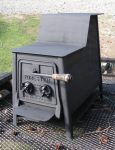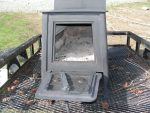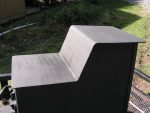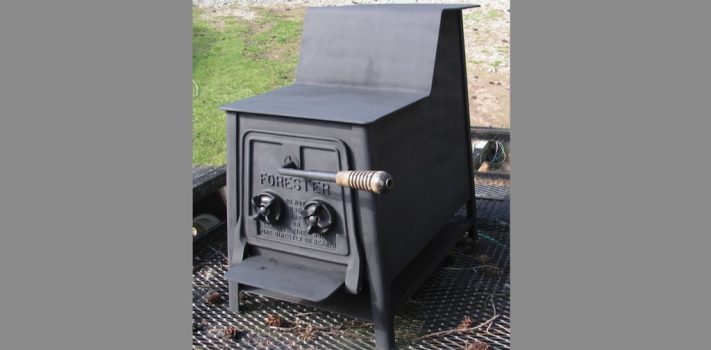Wood stoves are the heart of everything that happens at a off-grid homestead. The obvious reason is that it provides heat that keeps the home warm and comfortable, yet it can also be used to cook and preserve our food, boils water for drinking and cleaning, and just as important, wherever it is located there will be the family gathered together.
The Fisher/Forester style stoves were produced in the the early 1980s all over the U.S. in small and large metal fabrication shops that purchased the doors that had the name brand cast into the door. Had the name plate been Fisher that marketed their Bear line of stoves that became widely sold and earned a very positive reputation, this same stove might be advertised in excess of $1,000 on Craigslist or eBay even without a fresh coat of paint.
The reputation of these stoves is well deserved. But they were cleverly marketed and featured certain brass ornamentation that could cozy up a home. So it became fashionable to show off the latest adornment the house could afford. It wasn’t just another unimpressive hunk of steel, but became a part of the furniture and today it has some collector value.
Because of the price of these now-collectable stoves, I’ll skip the bling and choose a utilitarian model. I’ll choose a Chevy instead of a Cadillac, or in this particular case, one with the Forester nameplate. The best car value has always been the “base model” that has no radio, A.C., or power windows.
When shopping for anything, the uglier it is, then the low in price it will be. Its appearance may have nothing or little to do with its reliabilty and good function. I once sold a collectible vehicle that I had restored mechanically, yet because the paint was bad, the sale price was low. To their disadvantage, buyers typically do not look under the hood or appreciate the soundness or mileage and will pay big bucks for good-looking junk.
Few will sell “a good horse”, unless it is of course big, heavy and ugly. For wood stove: Look for cracks and holes in the metal and at the seams where it was welded together. Warped surfaces are an indication that it was run for too long at excessive temperatures. And make sure that it has fire brick and that if it was used then the firebox likely did not suffer from excessive heat erosion on the floor of the stove. In a dark room, when I see a dull red color on my stoves I will reduce the air intake and slow the burn down some unless of course it is -30F and I’m struggling to heat the place.
The Featured Stove
 The photos in this article show a stove that is essentially a rebranded Fisher stove design. It is featured in this article because it is what I believe is a good example of what is a good wood stove for an End of the World scenario. This is an example of what could be purchased by those on a tight budget. Recently, I priced new airtight stoves for sale at a local lumber yard. These were not fancy stoves, yet the price started at $3,000. I paid just $50 for this one.
The photos in this article show a stove that is essentially a rebranded Fisher stove design. It is featured in this article because it is what I believe is a good example of what is a good wood stove for an End of the World scenario. This is an example of what could be purchased by those on a tight budget. Recently, I priced new airtight stoves for sale at a local lumber yard. These were not fancy stoves, yet the price started at $3,000. I paid just $50 for this one.
 I believe this particular design is one of the best as it has a smaller door that opens downward and because of the long and narrow firebox. Its long and narrow footprint allows it to fit in more locations than a wider stove that opens to the left or right. While not as efficient as a modern Blaze King or other modern air-tight stoves that burn the wood gases produced from the combustion of the wood, these are still an excellent choice given their much lower price as a used stove that is a fraction of that of a new modern airtight stove. With my stove, $50 included delivery and some stove pipe!
I believe this particular design is one of the best as it has a smaller door that opens downward and because of the long and narrow firebox. Its long and narrow footprint allows it to fit in more locations than a wider stove that opens to the left or right. While not as efficient as a modern Blaze King or other modern air-tight stoves that burn the wood gases produced from the combustion of the wood, these are still an excellent choice given their much lower price as a used stove that is a fraction of that of a new modern airtight stove. With my stove, $50 included delivery and some stove pipe!
It was a remarkably unattractive stove when it was delivered. It was severely rust-stained and just plain ugly. Scary ugly. The previous owners were very happy to get rid of it and almost begged me to buy it. I promptly sanded and painted it after repairing the door latch by welding on a new one. (I use the skills learned fixing bent fenders and painting vehicles when I was young and dumb and into cars.)
This stove is made from very thick steel plate. High quality virgin U.S. steel made these stoves durable. It was ‘over-engineered’ and built like a tank and could therefore produce more heat without becoming damaged. They also provided large flat surfaces that can be used for multiple and larger pots or skillets. This particular stove can accept wood that is up to 24 inches long.
While not as efficient as a modern stove, it has redeeming virtues in that these stoves could last a lifetime and be used for not only heating a home, but for cooking as well. The Forester badge was not as popular because it was not associated with the Fisher brand name that was aggressively marketed. Using the same basic design, Forester stoves were also considered to be highly desirable, but their resale price decades later is generally less.
 The overall measurements of the featured stove in the photo is 36 inches long, 19 inches wide, and 31 inches tall. The interior of the firebox measures 16 inches wide, 16 inches high, and 29 inches deep. The fire brick that is necessary to protect the steel from heat erosion reduces the usable firebox space by 3 inches in width and length. If you buy a stove with broken or missing firebrick, it should be immediately replaced.
The overall measurements of the featured stove in the photo is 36 inches long, 19 inches wide, and 31 inches tall. The interior of the firebox measures 16 inches wide, 16 inches high, and 29 inches deep. The fire brick that is necessary to protect the steel from heat erosion reduces the usable firebox space by 3 inches in width and length. If you buy a stove with broken or missing firebrick, it should be immediately replaced.
My Forester stove uses 6-inch diameter stove pipe that exits the rear. There are no structural flaws. There are no cracks or warped metal surfaces and is an example of a good used wood stove. Be sure to inspect the outlet to make sure that it is not excessively eroded by rust. Adding a heavy steel 90-degree elbow to the stove would be the only worthwhile improvement that could be made to stoves that exhaust the smoke from the rear.
These older stoves are heavily constructed and durable — much more so than modern stoves that typically use lighter gauge steel plate made in Asia. Most of the metal that Asia sources to make its steel is not virgin steel, but rather an alloy comprised of various metals that are recycled. This steel is perhaps not a good one as a good as U.S. virgin steel, but more of a metal of various metals blended together and what is sometime referred to as ‘pot metal’.
This one is in good operational and overall good condition. The price of a new and modern airtight stoves are at least quintuple or higher in price, yet not necessarily as durable as a simple and heaviily-constructed stove such is this one. If you can find a good used modern stove that is also highly efficient, that might be the better choice.
When buying any wood stove, first and foremost, make certain of the quality of its construction. Very inexpensive stoves are usually less than ideal to operate and would cause me to wonder about its durability and reliability. This is especially important for anyone who intends to depend upon a stove without the prospect of replacing it, should it fail. Regardless, I have several backup stoves available nearby that I can quickly and ideally single-handedly move into position should my primary stove fail for some unanticipated reason.
BackUp Stoves
It is not a bad idea to have a spare wood stove that is quick and easy to install with the appropriate stove pipe with the replacement stove. It would not be a bad idea to store it in a convenient location. Good wood stoves are very heavy. Choose a replacement stove that can be handled by no more than two men. You do not want a stove that requires four men and boy to move.
I leave my spare stove on a dolly ready to move into place, and I have many lightweight portable stoves such as the M1941 military tent stove that I can pick up with one hand. And I have a variety of small cook stoves that could be thrown into the role of stove for heating, in an emergency. The featured stove required just two old men to move and one big and strong man if he is well-motivated and in excellent condition. If you cannot wrestle the stove into place on your own then it is too heavy to be used as a backup stove that could be quickly be pressed into service.
Do not forget to check the fit of the replacement stove and place it in the position where it would be used in the event of an emergency and be sure to have the stove pipe that will safely attach it to the chimney pipe. Again, for a back-up up stove, It mest be ready for immediate installation. I would also have replacement pipe available for the primary stove as well. By the time someone notices that a stove has burned through, it might be already at a stage that is unsafe to operate. Like a high mileage car, you never know when what was a reliable vehicle for many years becomes suddenly unsafe to operate.
Choose your wood stoves wisely. I use the term in the plural form as without a stove that literally preserves life, we could perish in misery, rapidly or slowly. As all stoves will wear out due to heat erosion or damaged by excessive operating temperatures, having a whole replacement stove and appropriate stove pipe is a top priority, in my book. I would choose a slightly oversize one that is of the highest quality, of a proven and desirable design, and one that is rated to heat more square footage than where it would be installed. A stove will have a longer service life and the risk of fire would be less if a stove can hold a fire longer and burn a larger supply of wood loaded into it for a longer period of time. A stove that is slightly too small will have to be run hotter and more often at temperatures that cause heat erosion and possibly warp the metal.
Practical Considerations
We are all limited by our budget and we no longer have the luxury of time to find the most suitable stove at the price we can afford. This is especially so if we have not yet purchased our first stove and even if we have not yet purchased an alternative or backup stove. If one can invest in a modern stove and a larger stove that accepts longer logs the amount of cutting needed to supply that stove can be reduced. This is only true if we do not have to split large rounds into a manageable size. The longer the log that we can handle and feed the stove, the less we need to run our saws. This is not only a labor-saving consideration, but also a logistics consideration. The less that the saw needs to run to cut the same number of cords of wood, the less fuel, bar oil, replacement chains and/or chain filing is needed.
Modern wood stoves burn wood much more efficiently yet the price of these are several orders of magnitude higher, and not without good reason. A modern stove such as the Blaze King has a catalytic device that burns the gases produced by the initial fire, thereby producing more BTUs per pound of the combustible material than older and less efficient stove designs. This means that less wood needs to be cut and hauled. The ability to burn less wood in order to meet our survival requirements is a significant advantage.
If we can not afford modern stoves that are typical in the thousands of dollars for a new example, to reduce our need to cut and haul wood we could also limit our living space, or use a stove with a longer firebox that accepts longs that are longer in length rather than shorter in length. Some modern airtight stoves will only accept wood cut longer than 14 inches. The featured stove accepts logs up to 24 inches.
Conclusion
During the dystopian future that is now unfolding, be it a Greater Depression as Gerald Celente first postulated nearly a decade ago to the extreme end of spectrum, or a total grid-down societal collapse that is well depicted in the novel Patriots, a wood stove will be an absolute essential tangible asset with a priceless value. In my opinion, different regions of the country will experience a spectrum of bad outcomes. Before you buy any books, buy a wood stove that you can immediately afford.










